|
|
|
13 November 07: Been a long time since some
South Street Bridge
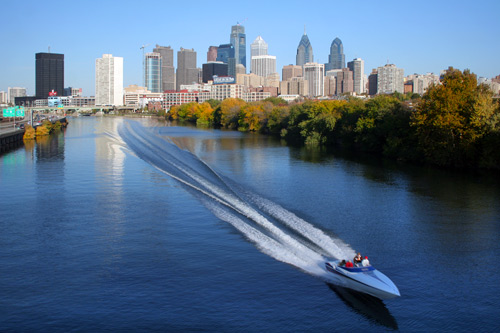
Ooooh. Lemme get back, lemme get back, lemme get back. Baby where I come from.
It's been a long time, been a long time, been a long lonely, lonely, lonely, lonely, lonely time.
Yes it has.
(This is kind of unintentionally/intentionally hypocritical/ironic/asinine/jackass-ish to reference a Led Zeppelin song from the same overexposed album as Stairway to
Heaven, which I complained/laughed/blurted about yesterday. I mean it was in a Cadillac commercial for like five years. Can you believe I am even talking about this? I am
an idiot.)
You know, I'm not totally opposed to motorized boats on the Schuylkill River and would actually quite be encouraged by the presence of more recreational boats there, but as
loud as this boat was zipping by under that infamous 84 year old crumbler, it was a little . . . obnoxious? Not sure which word I'm looking for here. No sir, I didn't like
it.
But there it is, yr Tuesdee PSSSBS (Philly Skyline South Street Bridge Skyline). The skyline, she looks-a good, yes?
–B Love
|
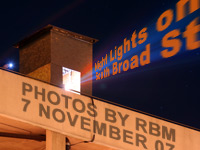 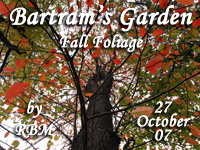  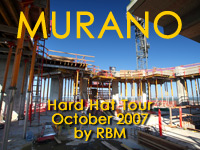
12 November 07: Give my regards to Broad Street
|
 Last Wednesday's evening lighting project along South Broad Street was, in a sense, the second phase of a more regular initiative to light the Avenue of the Arts, with the first
being the City Hall Christmas wonderland two years ago. Wednesday's event, produced
by Center City District, bathed the building façades of the Ritz-Carlton (the former Girard Bank lobby portion with the dome, not the hotel tower), the Merriam Theater
and University of the Arts' Anderson Hall and Hamilton Hall, the 1826 Greek Revival building by William Strickland. These four buildings featured the artwork of UArts students
projected from machines mounted across the street, in plain boxes, platform boxes, and one box installed atop the Wilma parking garage.
Last Wednesday's evening lighting project along South Broad Street was, in a sense, the second phase of a more regular initiative to light the Avenue of the Arts, with the first
being the City Hall Christmas wonderland two years ago. Wednesday's event, produced
by Center City District, bathed the building façades of the Ritz-Carlton (the former Girard Bank lobby portion with the dome, not the hotel tower), the Merriam Theater
and University of the Arts' Anderson Hall and Hamilton Hall, the 1826 Greek Revival building by William Strickland. These four buildings featured the artwork of UArts students
projected from machines mounted across the street, in plain boxes, platform boxes, and one box installed atop the Wilma parking garage.
The star of the evening, though, was the Terra Building at Broad & Walnut. The 17 story building by Horace Trumbauer was lit up by mounted LED lights programmed by Philly's own The Lighting Practice, splashed color onto an otherwise subtle building and accentuated the renovation work MGA
Partners did on the lower floors in 2000.
The Terra Building's scheme is meant to be permanent and stands to serve as a sign of things to come down the Avenue of the Arts. LEDs are scheduled for 2008 to adorn a number of
other buildings on South Broad between City Hall and South Street including the big (PNB Building, Wachovia Building, Land Title and Land Title Annex), the stately (Bellevue, Union
League), and the otherwise unnoticed (Bellevue's parking garage, Starbucks at Pine).
The show was unveiled to the sounds of Beethoven's Symphony No. 5, my one minor nitpick in an otherwise fun and festive evening full of freaks and weirdos. I mean, it's a nice piece,
but it's just that it's the Stairway to Heaven of classical music. But that's an awful small complaint.
Overall, it was a fun show and even if you think bright colors are gaudy (in which case you probably don't like Cira Centre after dark), you have to admit that they spruce
up an already pretty lively pedestrian experience. There are 25 images in this photo set, all on one easy-to-use popup page. (It totals about 5M, so give it a second to load.)
GO TO PHOTOS
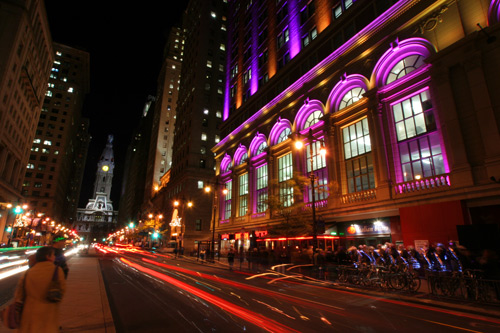
–B Love
|
12 November 07: Quick spin
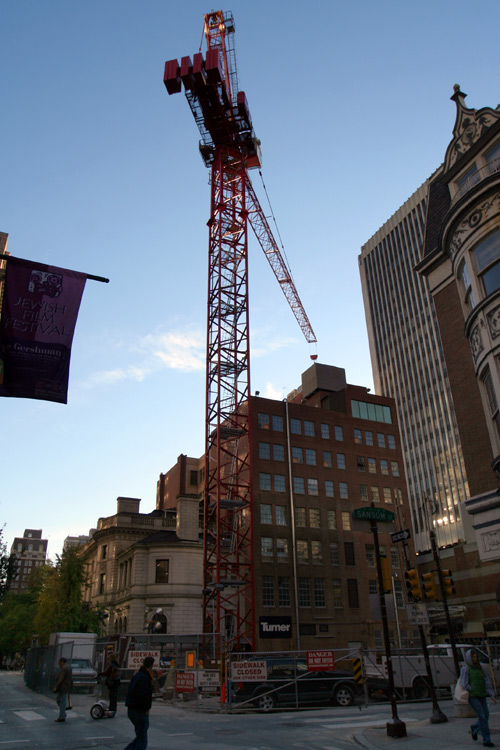
Greetings and salutations, ye friend of Philly Skyline, and thank you for your patience as we gather and prepare our thoughts which will hopefully be one of the most productive weeks
we've had. There are a number of essays being compiled as we speak, and rather than waste any time talking about them, we're just gonna go ahead and launch em when they're ready. But
real quick on this 'ere Monday, a round of Casual Observations look a lil' something like . . .
- 10 RITTENHOUSE SQUARE, SERIOUS BUSINESS: The crane in the photo above? 10 Rittenhouse Square's. It was assembled and mounted over the weekend,
and in its infantile form is already visible from as far south as Point Breeze. (FYI, 10 Rittenhouse Square is one of the aforementioned projects we're working on.) The foundation is
poured and the ground floor is being worked on as we speak.
(And yes, there is a woman riding a Segway in the lower left portion of that photo . . . why? I have no idea. Segways look stupid, they are impractical, they don't belong on
sidewalks OR in bike paths, and they are elitist toys that immediately paint their buyers as spendthrift idiots better off playing magnetic chess at the Sharper Image. Yr Philly
Skyline is decidedly anti-Segway.)
- IMPLOSION OF THE NATIONAL BUILDING, WHO KNEW: Hey Convention Center expansion, thanks for the heads up! As I said a couple weeks ago when the
Sands was imploded, implosions should be cause for a party and celebration, like death parades in New Orleans. They should be well attended celebrations with a public New Years-like
countdown and lots of cheering. Like the Sands in Atlantic City.
In Philadelphia, implosions are held at 7am on Sundays when either people are not awake, they're agitated to be awake, or they're on their way to church. Even The Vet was done this
way, albeit far more publicized than the implosions of, say, failed housing project towers. (Speaking of, we're doing what we can to find out the fate of Mantua Hall, so if/when a
time and date for its implosion is known, it will be posted right here.)
The Convention Center had an opening party for the four-square-block demolition project it initiated, but I didn't see a damn thing about this. Lucky for me, the Inquirer's Akira
Suwa has video of it HERE and Andrew in G-Ho has a nice Flickr set of it HERE.
- YESTERDAY AND PHILADELPHIA BEAUTY: I've been in Philadelphia for seven years now (it feels like longer), and I know -- I am 100% certain --
that I have never seen a more photogenic day than yesterday, and I have never seen a more beautiful sight than that which I saw at sundown last night. Instead of working on essays
and projects and skinnys yesterday, the most fall day of fall days drew me to the great outdoors, most of which you can see in the latest Comcast
Center update (pages 3 and 4). But up at the Plateau, I was just floored.
The subject of yesterday's Philly Skyline Veterans Day Skyline, the scene was that out of some über-saturated Hollywood love story: the clear blue sky, the lone maple tree in
peak orange color with just enough fallen leaves to color the surprisingly unlittered ground, the setting sun painting the skyline, but in particular, Comcast Center. That object of
such attention commanded it as I've never seen any building do before: the entire building reflected the sunlight like a second sun, a giant stick of solar radiation.
That's how this 'ere quick spin will end.
The way I shine is like a zillion dollar light bill.
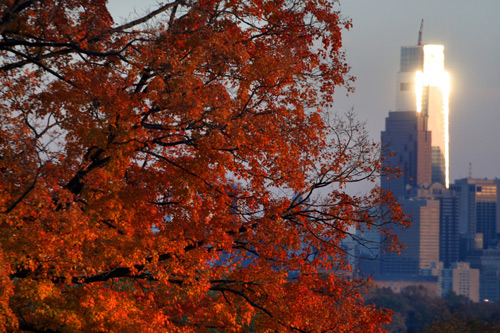
–B Love
|
   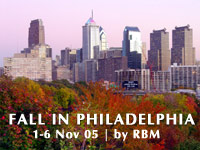
11 November 07: Veterans Day sunset at the Plateau
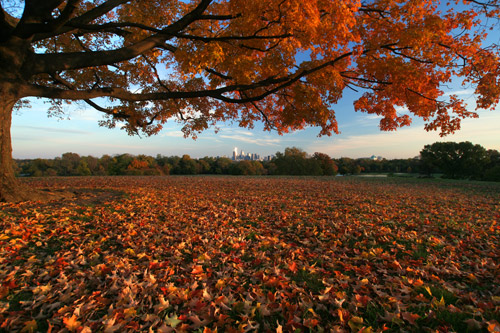
The scene at 4:30 on 11/11; fall in Fairmount Park.
–B Love
|
9 November 07: Living just enough for the city
That there is Stevie Wonder performing his powerful social commentary anthem 34 years ago, and it's as strong today -- or rather, last night at the Wachovia Center -- as ever. But
for this afternoon's post, let's take the mood and ideals of another Stevie classic (which he also performed in Philly last night): Love's in need of love today. Today is love,
shout-outs and love that need some love. Here we go here we go here we here we go.
* * *
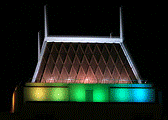 INGA LOVE:
A little better birthday bureau birdie done told me that it's a certain somebody's birthday today. And so to her from all her friends at Philly Skyline (but probably not from
Symphony House), HAPPY BIRTHDAY! Speaking of Symphony House and birdies, ayyyy cuckoo! The architect of that building offers a rebuttal in today's Inquirer HERE. INGA LOVE:
A little better birthday bureau birdie done told me that it's a certain somebody's birthday today. And so to her from all her friends at Philly Skyline (but probably not from
Symphony House), HAPPY BIRTHDAY! Speaking of Symphony House and birdies, ayyyy cuckoo! The architect of that building offers a rebuttal in today's Inquirer HERE.
This reminds me: 2008 calendars are in production as we speak, so look for an announcement in the coming weeks about a launch and party and how to purchase and good times and so
forth.
* * *
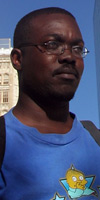 STEVE IVES LOVE: Major, major props to Philly Skyline senior vice president of urban affairs and West Philly Warrior #1 Steve Ives for placing second in Metro's "Colors of my city" photo challenge. If you type "Ives" in the search field and pull the menu to "Last Name" it will
bring up the five photos he submitted -- the one in the middle (accordion player) is the one that earned him his runner-up. Congrats are also in order for our good friend Albert Yee, who took third. (And to be fair, congrats also to grand prize winner Jason Melcher for his excellent photo of
what I interpret as a student passed out on Temple's campus.)
STEVE IVES LOVE: Major, major props to Philly Skyline senior vice president of urban affairs and West Philly Warrior #1 Steve Ives for placing second in Metro's "Colors of my city" photo challenge. If you type "Ives" in the search field and pull the menu to "Last Name" it will
bring up the five photos he submitted -- the one in the middle (accordion player) is the one that earned him his runner-up. Congrats are also in order for our good friend Albert Yee, who took third. (And to be fair, congrats also to grand prize winner Jason Melcher for his excellent photo of
what I interpret as a student passed out on Temple's campus.)
Anyway, in-house kudos for Steve, who just earned himself a year-end bonus. I'm going to keep on him to make sure he gives us a 2007 photo recap like he did in 2006. Enjoy that one and Steve's other photo and written essays in his archives HERE.
* * *
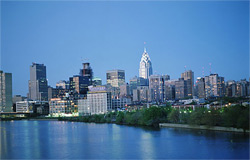 ILLADELPH LOVE: Good lookin' out, homies. When yr Philly Skyline was offline for a B Love vacation last week, The Illadelph picked up Skyline details and railed on the AP, USA Today
in particular, for running the TWENTY YEAR OLD STOCK PHOTO at right with their story.
ILLADELPH LOVE: Good lookin' out, homies. When yr Philly Skyline was offline for a B Love vacation last week, The Illadelph picked up Skyline details and railed on the AP, USA Today
in particular, for running the TWENTY YEAR OLD STOCK PHOTO at right with their story.
Look, that photo, by ____ (iwishinu, seriously -- if you are that photographer or if you know, please let me know), is very nice. Keeping chronology of a
city's growth and evolution, particularly through its skyline, is a worthy and interesting cause. If I do say so myself, that is . . . I mean look at our Comcast Center section: half of the pictures are of just the building, but the other half
are of the building in the skyline, because that's where it is, in our city and in our perception.
The AP's Deborah Yao managed to get a whole story out of Philly apparently
trying to shake its blue-collar image in places that don't run the "Philly's more ugly fun when you sleep over" ads. That's fine, and I don't blame her for this
story; I blame the USA Today for being USA Today lazy. My god - this was the first image they saw in a "Philly skyline" stock photo search??? It's 2007!
In this internet-Flickr-Myspace-esoteric-interest age, people actually notice these things, not least marketing firms. So why is it that old media gets so bent when new media calls
it out on being out of touch yet they continue to do things like run 20 year old photos for contemporary stories about cities?
Jeez, take Comcast itself. I haven't been able to catch a screencap of it, but one of their (8,000) current tv spots has a drum-&-bass song in the background and an orange graphic of
a "generic" city skyline that is clearly Philly's, taken from the Mann Center and inverted -- without Comcast Center, its own headquarters. Am I just being a nerd about this?
* * *
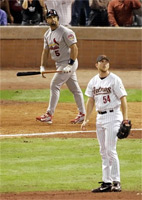 PHILLIES LOVE: When I heard that the Phillies sent Michael Bourn, Geoff Geary and third base prospect Mike Costanzo to the Houston Astros in exchange for Brad Lidge and Eric
Bruntlett, the first image that popped in my head was the one at left, just like anyone else who doesn't really follow the Astros closely. That, and the young Bourn would be gone and
Brett Myers would be pissy about probably having to move back into the starting rotation. But after further review, the trade totally makes sense: Myers hasn't exactly earned enough
stripes in the organization (wife beating, "fuckin retard" for example) to call his own shots, and putting him back into a lightweight rotation immediately boosts it. Lidge,
whether he choked against Pujols or not, has been a solid and proven closer. All things considered, it's a pretty shrewd move by Pat Gillick, so let's see where he turns his
attention and team money now: JC Romero? Almost there, says Todd Zolecki. Aaron Rowand? Let's hope so. Mike Lowell? Yeaaah no. Sal Fasano? Hey, he's available!
PHILLIES LOVE: When I heard that the Phillies sent Michael Bourn, Geoff Geary and third base prospect Mike Costanzo to the Houston Astros in exchange for Brad Lidge and Eric
Bruntlett, the first image that popped in my head was the one at left, just like anyone else who doesn't really follow the Astros closely. That, and the young Bourn would be gone and
Brett Myers would be pissy about probably having to move back into the starting rotation. But after further review, the trade totally makes sense: Myers hasn't exactly earned enough
stripes in the organization (wife beating, "fuckin retard" for example) to call his own shots, and putting him back into a lightweight rotation immediately boosts it. Lidge,
whether he choked against Pujols or not, has been a solid and proven closer. All things considered, it's a pretty shrewd move by Pat Gillick, so let's see where he turns his
attention and team money now: JC Romero? Almost there, says Todd Zolecki. Aaron Rowand? Let's hope so. Mike Lowell? Yeaaah no. Sal Fasano? Hey, he's available!
* * *
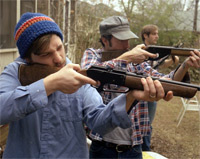 DR DOG LOVE: Hey now ladies and gents, the beloved boys of West Philly rock & roots are wrapping up their cross-country tour with a date tomorrow night at the TLA. Music critics want
to compare them to the Beatles and Beach Boys, which is just ridiculous in principle but well okay makes a little sense when listening to We All Belong; Wilco and My Morning Jacket
want to tour with them; Beck wants to remix them. That's pretty impressive company, boys: well done. Support these guys because they're awesome and because they're ours. Tomorrow night at the TLA, yo.
DR DOG LOVE: Hey now ladies and gents, the beloved boys of West Philly rock & roots are wrapping up their cross-country tour with a date tomorrow night at the TLA. Music critics want
to compare them to the Beatles and Beach Boys, which is just ridiculous in principle but well okay makes a little sense when listening to We All Belong; Wilco and My Morning Jacket
want to tour with them; Beck wants to remix them. That's pretty impressive company, boys: well done. Support these guys because they're awesome and because they're ours. Tomorrow night at the TLA, yo.
(Photo from To Austin and Back in 20 Days, a blog of photos by Michael Withers of a road trip with Dr Dog to
SXSW.)
* * *
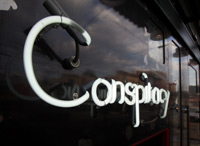 CONSPIRACY LOVE: I would definitely be at the Dr Dog homecoming show were I not already committed for an even bigger milestone, the one year anniversary of Conspiracy Showroom. Those
three lovely ladies and their clothes/accessories/jewelry/stuff making friends have ridden the wave of success and good publicity (they've been mentioned in the NY Times and
Inquirer, they were up for City Paper's best local designers category, and they're a big part of the latest Illadates) to the biggest benchmark a small business in this business privilege havin' town can have: one year. Congratulations ladies and thank you for selling
my calendars and prints and for making me dinner sometimes. [Conspiracy Showroom]
CONSPIRACY LOVE: I would definitely be at the Dr Dog homecoming show were I not already committed for an even bigger milestone, the one year anniversary of Conspiracy Showroom. Those
three lovely ladies and their clothes/accessories/jewelry/stuff making friends have ridden the wave of success and good publicity (they've been mentioned in the NY Times and
Inquirer, they were up for City Paper's best local designers category, and they're a big part of the latest Illadates) to the biggest benchmark a small business in this business privilege havin' town can have: one year. Congratulations ladies and thank you for selling
my calendars and prints and for making me dinner sometimes. [Conspiracy Showroom]
* * *
LOVE, NOTHING BUT LOVE
Welp, that'll do for another week of weekdays at yr friendly Skyline. We'll try to wrap up the South Broad light show pictures this weekend, but you can check occasional Skyline
contributor Matt Johnson's photos of the same HERE. See you soooooooooooooon . . .
–Love, B Love
|
   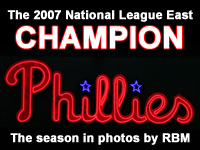
9 November 07: Independence National Historical Park Would Like To Keep You Informed During Construction On The Mall
With Capitalized Words
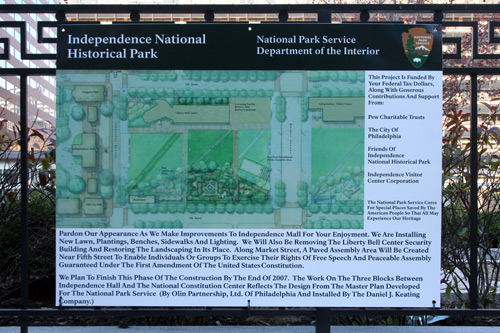
Click To Enlarge.
The Rendering Shows That The Curving Sidewalk Beginning At The Friends Meeting House At 5th And Arch Will Continue To Curve All The Way To Independence Hall, And A New First
Amendment Public Assembly Area. The Latter Is A Noble Idea Considering The Entire Premise Of The Park, But It's A Poor Trade-off For The Bike Rack Barriers Which Still Stand
Around Independence Hall And The Borderline Oppressive Security Booth To Enter The Liberty Bell Center.
It's What The Rendering Does Not Show That I Find Interesting: The President's House And Slave Quarters. Surely It Was Left Intentionally Blank Until A Decision On How To
Proceed Can Be Made, But If The Sign Is For Tourists, Surely Many Tourists Will Wonder How The Wooden Viewing Platform There (Also Not Pictured) Will Be Used.
Meanwhile Across The Street, Demolition On The Former KYW Building Continues, With A Small Sample Of The Future Museum Of American Jewish History On The Pedestrian
Scaffolding's Placard:
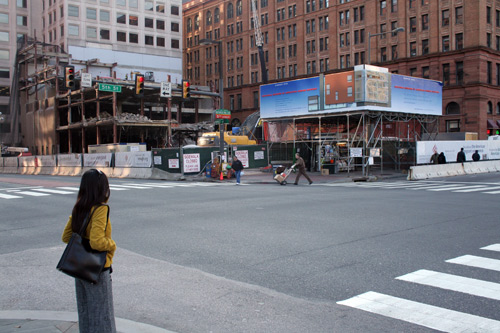
–B Love
|
8 November 07: Long, long, long

–B Love
|
8 November 07: Freak flag flew
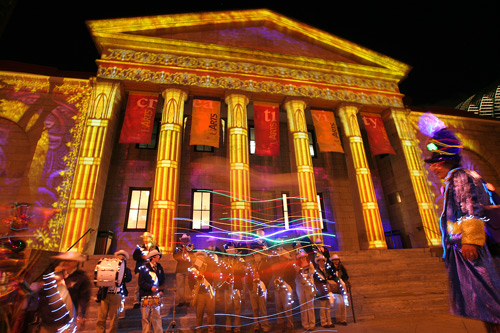
Oh man. BIG UPS to Center City District. I don't know that anyone could have predicted the aggregate faction of weird that would go with its South Broad
Street night lights party on Wednesday night. Neon clowns hula-hooping
on stilts, Sprockets dancers in video-game-simulation-suits on rollerskates, dudes juggling bricks, marching bands playing "Carry On My Wayward Son" . . .
well played, CCD, well played. And I think I saw Tisha Campbell getting out of an airport cab and entering the Ritz-Carlton.
Please consider the Philly Skyline Freaky Skyline above a preview of an entire set of photos from the night which will hopefully be up later today. There's a
lotta loose ends to tie up 'round these parts first, so in the interim, have a peak o'er at our Comcast Center section (now
with approximately 8 million photos), or perhaps a look back at CCD's last light-em-up, City Hall at Christmastime two years ago HERE.
See ya when I see ya, honeydips!
–B Love
|
   
7 November 07: It's Mayor Nutter Jelly Time
Mayor Nutter Jelly Time
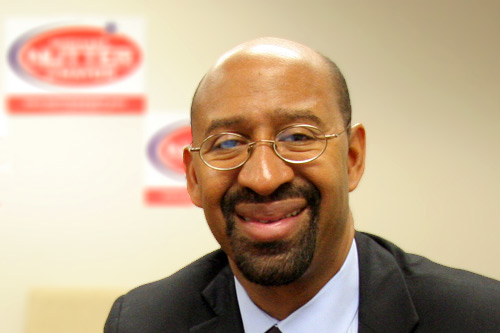
Mayor Nutter jelly with a baseball bat.
All the usual pre-election GOTV paranoia proved as usual baseless, as Michael Nutter won the election over whatshisname by a record 82.5%. On the other hand, only 270,000 people voted in a city of 1.5
million, Jannie Blackwell and Darrell Clarke were re-elected (Clarke ran unopposed), and Willie Singletary was elected as a Judge of Traffic Court in spite of his
own drivers license bring suspended until 2011 and being ON TAPE encouraging on-the-spot bribes implying the people would need him later.
Nevertheless. Mayor(-Elect) Michael A Nutter, you are the MAN. (You see what I did there.) Congratulations, my friend.
The Inquirer's Marcia Gelbart (who's done a great job covering the campaign and who did a great job on the Mayorpalooza blog before
it disappeared) has a nice piece in this morning's paper outlining the reality of what he's facing right now this minute. It's worth a read HERE. She's keen to mention that this first
day as Mayor-Elect is marked also by the funeral of fallen police officer Charles Cassidy, which is emblematic of the crime issue being the top of the top for the
incoming mayor. The same week Police Commissioner Sylvester Johnson took cheap shots at Nutter's
stop-and-frisk policy (which is only a portion of his plan,
but the one that has gathered the most controversy), his popular predecessor John Timoney helped catch a cop killer in Miami. Related? Of course not. But it's an
interesting observation, no?
Nutter Butter was on Radio Times this morning and The Next Mayor took notes. Check HERE for that, and go back later for an mp3
of the broadcast. Marty Moss-Coane and her team (as usual) did a great job of keeping the discussion well-rounded, i.e. it didn't stay stuck on crime.
One thing I found particularly interesting and which he'd touched upon occasionally during the campaign was this comment: "I want Philadelphia to be the #1 green
city in America . . . We need to change zoning code to encourage LEED building." This is promising, of course, but the way I see it, we need a major, major trendsetter
that we can use as an example, that should we actually implement this green idea, we can point back to as the forefather of that idea. No, I'm not talking
about Comcast Center. I'm talking about the Convention Center.
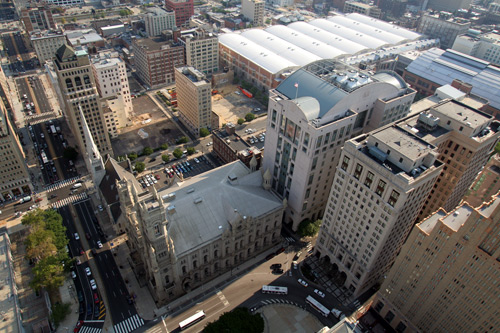
You may recall this PSPS from our August essay on the ceremonial beginning of demolition for the
$700M expansion of the Pennsylvania Convention Center. Click the image and soak in all the red -- these are the four city blocks the city is losing for that
expansion. The expansion by the Convention Center Authority which was chaired for four years by one Michael Nutter.
This is our chance to put our money, all three-quarters-billion of it, where our mouth is. Four square blocks -- 376,000 of saleable space -- is an awful lot of
construction. And considering the demolition has only just begun and contracts haven't gone out for bid yet, there is time to make this enormous superstructure construction the example of green initiative Mayor(-Elect) Nutter
wants, and Mayor(-Elect) Nutter is the person to make it happen.
The Convention Center is already a behemoth, and when finished in 2011, it's going to be even behemoth-er. Looking at the existing structure from above (as in the
image directly above), it looks like a washboard turned on its side, or a bunch of long pillows lying next to each other with symmetrical vents. Or maybe seven
packs of cookie dough. Extending those packs of cookie dough all the way to Broad Street would be yet another Philly missed opportunity. But with an incoming Mayor
Nutter, we can look realistically at the Possible City. Picture a landscaped roof that covers four city blocks. It's a veritable park
in the sky! (You might say it's pie in the sky, but why?) Solar panels? Wind turbines? Rain collection barrels? Granola vendors?
Philadelphia has the largest park system in the country, and more green space would never hurt. But green space in the figurative sense is, to this point in this
city, few and far between. The Big Green Building at Broad & South is a wonderful specimen of what the future could look like, but it doesn't have nine-digit
figures of state capital behind it. And, as far as public observation areas go, City Hall is it. A big green park five stories above street level on a
(re-)burgeoning Broad Street, with a view of City Hall and William Penn looking right back at you . . . well what do you think about that?
Go green, Convention Center. Mayor(-Elect) Nutter, what do you think about that?
–B Love
|
6 November 07: Three for eleven
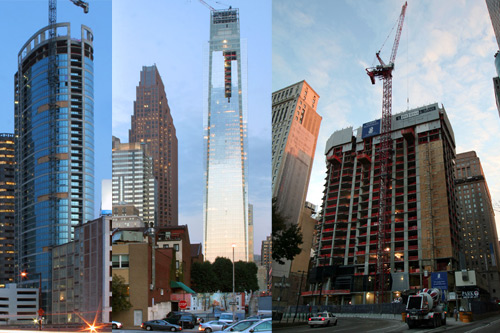
As in: the big three items of Philly Skyline construction production are now November members. The photos are live HERE, HURR and HEEAH, but a closer inspection look a lil somethin like . . .
COMCAST CENTER is super duper close to completion. Well, the exterior anyway. The glass is finished on three sides, and as
you can see from the image above, the west side's glass is almost zipped up where the hoist once was. The crane is to be removed from the top of the building
this week.
MURANO is well topped off at 42 stories, its glass has only two floors to go, and its crane will too soon be dismantled. No
official word yet on who'll be the tenant at ground floor on Market Street, but I'm sure they'll form an alliance of sorts with the Forum just across the street.
RESIDENCES AT THE RITZ-CARLTON is now up to twenty floors, almost halfway to the top. Glass has been installed along 15th
Street, just in time for Michael Nutter to look out his window across the street and see his victorious reflection.
Worth noting in a Center City walk-through last night was the construction of 10 Rittenhouse Square, which has now reached street level, and you know what that
means: Bee Love needs to get on the bizzall and make a 10 Ritt section like the others above. All righty then, consider that top priority right now this minute.
Stay tooned.
–B Love
|
   
6 November 07: The Possible City
Around the Mulberry Tree we go
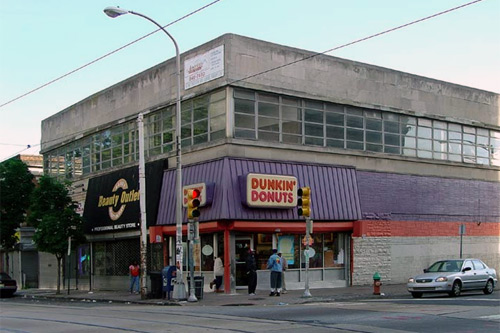
by Nathaniel Popkin
November 6, 2007
Thanks to quite a few readers, we now have a thorough list of critical neighborhood locations to explore. The most votes seem to be for Germantown & Chelten, a
spot which I've been thinking about recently as part of Hy Zelkowitz and Tod Cortlett's industrial design studio at Philadelphia University. Broad & Olney and
Oxford Circle were other popular nominees. It's a terrific list of all different kinds of places, including some which are predominantly residential. I expand
the MCP hospital site to include the Allegheny Avenue area that is about to lose TastyKake.
Here's the complete list:
North:
•Oxford Circle-Five Points
•Wayne Junction
•North Philadelphia Station -- expanded area
•Kensington and Allegheny
•MCP site to Allegheny Avenue
•Germantown and Chelten
•All of Germantown Avenue
•Broad/Ridge/Fairmount/Girard
•Broad and Olney going east and west
•5th and Boulevard going north, lower NE
•Fox Chase
•Erie/Torresdale Station
•Broad and Erie
•Stenton and Washington Ln
•Cottman and Castor
South:
•Broad/Snyder/Passyunk
•Pattison and Penrose
•Front and Snyder
West:
•Lancaster Avenue
•52nd Street
•Chester-Woodland-49th to 54th Street
As for one of the core ideas presented in Wondering about Wandering, the expansion of center city, Paul Levy, Center City District President and CEO, sent along
his organization's 2002 report on that same idea. His analysis shows
that neighborhoods with small median household size already express one of the key attributes of downtown living.
With the clocks falling back for winter, Philadelphia falls into its strange annual hibernation. Neighborhoods particularly lose the rhythm of street life. This
isn't a factor of chill air per se, as it's still plenty warm out, rather wholly inadequate lighting. Poor lighting means stores can't stay open late, which
means they can't make enough money to stay open at all. It means it at least feels unsafe to stand -- at 33rd and Lehigh, say -- and wait for the bus, which runs
less frequently at night in the winter. It's a cycle that ends in misery. The cobra lights that illuminate the middle of the street leave the building edge and
sidewalk dark -- and darkness is our enemy. We need to light our sidewalks if we wish to return life to the neighborhoods. There is no more straightforward
approach or a better return on investment. In the spirit of rewarding wandering, neighborhood monuments -- libraries, post offices, churches, schools, public
spaces, sculpture, murals, and gardens ought to be properly lit, as they are now in Center City. Merely lighting one or two monuments per neighborhood would have
the effect of reinforcing identity, clarifying the connection to history, and beckoning us out despite the date on the calendar.
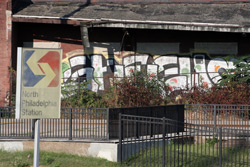 While we're on the subject of relatively simple (though certainly not inexpensive) things to make things better, it's worth revisiting an idea I posited last
week: the $10 billion fund to preserve at-risk neighborhood blocks. I've come to realize this is a proposal for preservation on a grand scale and it got me
thinking of a dream Harmon Zuckerman, the epic Philadelphian who heads up the Douglass County (Nevada) planning department, has for a system of classification and
organization of architectural elements. Harmon always figured that by classifying all the stuff being picked through during demolition, Philadelphia could profit
from its demise. With the $10 billion fund, it would be possible to aggregate materials from certain seriously degraded rowhouse blocks for use on other more
strategic blocks in relatively better shape. This occurred to me while fifty six-year-olds ran around a Mulberry Tree in the side yard of a house in Fishtown.
It wasn't the tree so much as the French-style fireplace and an iron gate and the front door, etc., all assembled from various local sources, that got me
thinking. While there are a couple dealers in architectural objects, what I envision is a central warehouse and database of items from claw foot tubs to doors,
shutters, cornices, metal work, to flooring, joists, and fireplaces. Here is economic and environmental sustainability in a nice package. And potentially lots
of jobs too.
While we're on the subject of relatively simple (though certainly not inexpensive) things to make things better, it's worth revisiting an idea I posited last
week: the $10 billion fund to preserve at-risk neighborhood blocks. I've come to realize this is a proposal for preservation on a grand scale and it got me
thinking of a dream Harmon Zuckerman, the epic Philadelphian who heads up the Douglass County (Nevada) planning department, has for a system of classification and
organization of architectural elements. Harmon always figured that by classifying all the stuff being picked through during demolition, Philadelphia could profit
from its demise. With the $10 billion fund, it would be possible to aggregate materials from certain seriously degraded rowhouse blocks for use on other more
strategic blocks in relatively better shape. This occurred to me while fifty six-year-olds ran around a Mulberry Tree in the side yard of a house in Fishtown.
It wasn't the tree so much as the French-style fireplace and an iron gate and the front door, etc., all assembled from various local sources, that got me
thinking. While there are a couple dealers in architectural objects, what I envision is a central warehouse and database of items from claw foot tubs to doors,
shutters, cornices, metal work, to flooring, joists, and fireplaces. Here is economic and environmental sustainability in a nice package. And potentially lots
of jobs too.
As for Jefferson University's new plaza, which I reviewed recently, it's even better at night, when the lighting scheme joins the Hamilton Building itself to
feign the atmosphere of a restored ruin. (The use of large stones in the plaza and the lighting of the column forms of the building's façade leave this
impression.) I had written about the need to activate the generous arcades of the Scott Library. I discovered later that there is a half-hearted attempt at a
café inside the western arcade, which is really a lounge area, counter without a barista, and a collection of vending machines. It's lackluster but only
reinforces the instinct to use the space for eating and drinking. Given what Jefferson has done to make the plaza feel un-like a hospital, and given how enticing
the plaza is, a restaurant with tables under the arcade would merely complete the picture. The University will anyway have to consider rethinking the plaza's
diagonal axis. Now, if you, as I do, walk southeast through the plaza from Walnut Street you'll run out of pathway well before the corner of 10th and Locust.
Instead, you either cross the main oval and then walk through the grass to the corner or turn left in front of Dr. Gross and walk out to 10th Street. But the
second alternative kills the diagonal -- which is the essential joy of using the plaza. Walking on the grass is fine, but it feels like a subversive act when it
clearly needn't.
–Nathaniel Popkin
For more on The Possible City, please see HERE.
For Nathaniel Popkin archives, please see HERE, or visit his web site HERE.
|
6 November 07: It's Election Day.
5 November 07: Smoky Mountain Memories
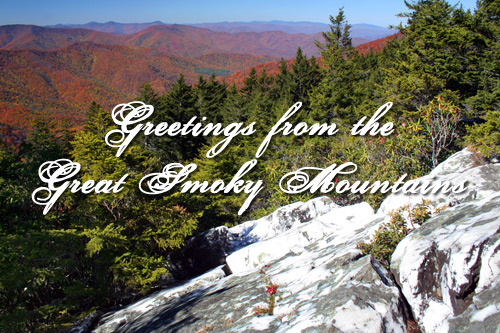
Hi y'all. Just hiked in from the Great Smoky Mountains and boy are my lungs tired. So did I miss anything?
Officer Charles Cassidy murdered by John Lewis: Well, there isn't really anything I can say about this that would do it any justice. I'm very sad for Officer
Cassidy's family, for the police department, and for the city. It's just terrible. RIP, Officer Cassidy.
Andy Reid has more than 99 problems: The sons and the drugs and the arrests and then the drugs in prison??? Sheesh, what terrible things to overshadow the
criticism his poor play calling and ego so deserve. And it's pretty apparent that he deals with his life's stresses by eating . . . I mean, there is out of shape and then
there is "may god have mercy on his unhealthy soul." If the last second loss to the Bears wasn't the door closing on the Reid-McNabb glory era of Eagles football, then
there's no denying that a primetime thrubbing by the Cowboys with TO racking up 10 catches for 174 yards and a TD is. "Ouch" doesn't even approach this. Here's hoping Andy
can finally admit to himself that he needs time away from football, for himself, for his family, and for the future of the Eagles.
On the other hand, the hi-def views of Philly on the Sunday Night Football broadcast were spectacular.
The W, now a face with a name: The forthcoming 29 story W at 12th & Arch by Starwood Hotels now has itself a look, and a pretty decent one at that. Designed by
Handel Architects (also responsible for the Residences at the Ritz-Carlton), it appears to take cues from the PSFS Building one block to its south, but with a contemporary
glass chic and what appears to be a northeast-to-southwest angle on the upper floors facing the Convention Center. The domain wphiladelphiaresidences.com is parked
for the moment, but you can scope two views at UrbRes.com. (Click on "Philadelphia".)
Tomorrow is Election Day: Repeat: TOMORROW IS ELECTION DAY! Vote Nutter. Duh.
* * *
Yr Philly Skyline will resume to regular programming tomorrow, but for your Fall-Back-Monday-afternoon-evening, here are some Great Smoky Mountain photos that might fit
nicely on your computer background. Peak fall foliage, 6,000+ ft mountains, sun, sky and fog, trails that wrap for hundreds of miles and thousands of acres, buckwheat
flapjacks in the morning and a massive slab of ribs in the evening . . . it's easy to see why Dolly Parton loves her Smoky Mountains. After the photos is that same lovely
lady from the Tennessee hills so famous for her big, uh, hair, singing a late 60s duet with Porter Wagoner, who passed away just last week. For Dolly and for Porter, for
the Smoky Mountain hills of Tennessee and North Carolina, and for the Timberland boots that garnered me a grand total of ZERO blisters over three days and forty miles of
hiking, I bid you adieu.
–B Love
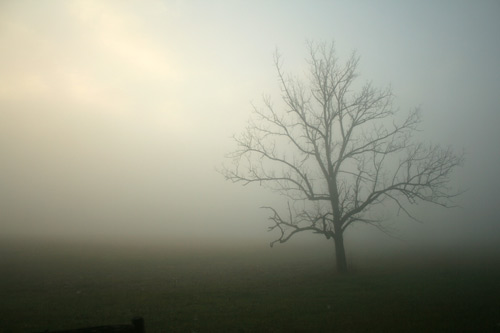
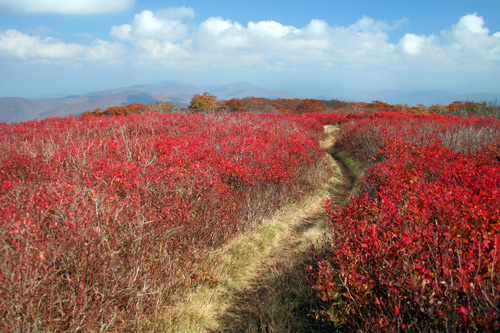
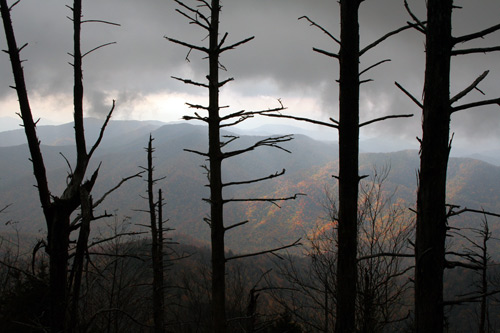
|
   
31 October 07: On a Tennessee Trip
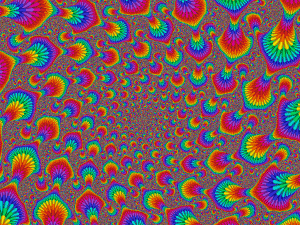
Ain't no smoggy smoke on Rocky Top, ain't no Comcast bills.
This 'ere Philly Skyline's pressing pause to go get lost in the Smoky Mountains, so we'll unpause and get back in action next week. Don't worry, we'll DVR everything.
See you on the other siiide . . . MAN.
–B Love
|
   
30 October 07: Sound Garden
|
 People always talk about the weather, because people always can talk about the weather. Conversations about politics and religion can end in frustration and fights. Conversations
about sports usually end in frustration (except in Boston). Conversations about sex lead to frustration and sex. But weather? Even your crazy Uncle Bob can talk about the weather.
And as climate change / global warming continue on such a pace that not only is green construction becoming commonplace but even freaking Chevrolet is making hybrid cars, people will
only be talking more about the weather.
People always talk about the weather, because people always can talk about the weather. Conversations about politics and religion can end in frustration and fights. Conversations
about sports usually end in frustration (except in Boston). Conversations about sex lead to frustration and sex. But weather? Even your crazy Uncle Bob can talk about the weather.
And as climate change / global warming continue on such a pace that not only is green construction becoming commonplace but even freaking Chevrolet is making hybrid cars, people will
only be talking more about the weather.
(I realize all war talk right now involves Iran -- it blows the mind that expanding this hopeless war is even being seriously considered -- but I'm calling it right now that within fifty
years there will be a war for Antarctica. Right now, the seventh continent is governed only by an international treaty establishing that it can ONLY be used for peaceful and scientific
missions, but let's see how an unstable world of over six billion people with half of it doing virtually nothing about greenhouse gases behaves for half a century. There will be
an Antarctic war, I am certain of it.)
Anyway, weather. I've said it a thousand times: the biggest reason I love Pennsylvania and the northeastern United States is the weather. We not only have all four seasons; we have the
extremes of all four seasons, and the best of these is always fall. The first frost, the harvest moon, the apples and pumpkins, the fall colors, the big bowl of meaty chili and the
October ale. All those recent weeks of hot weather had me worried, but last week, fall officially arrived with a cool wet spell and an email invitation to a fall foliage tour at
Bartram's Garden, rain or shine.
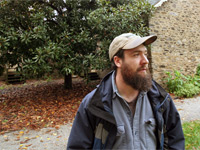 Well, it was pouring on Saturday morning and that delighted me to no end -- I would gladly make the trip to hold them to task, and the rain would keep the crowd small and manageable.
When I got there, the barnyard was soaked and still soaking, but under the overhang sat a cider press and a crate of apples. Don't mind if I do! As I was cranking away at the
freshest cider in the world, Bartram's head gardener Todd Greenberg popped out to survey the half dozen people joining him. "I love walking through the garden in the rain," he tells me
with smile that says he means it.
Well, it was pouring on Saturday morning and that delighted me to no end -- I would gladly make the trip to hold them to task, and the rain would keep the crowd small and manageable.
When I got there, the barnyard was soaked and still soaking, but under the overhang sat a cider press and a crate of apples. Don't mind if I do! As I was cranking away at the
freshest cider in the world, Bartram's head gardener Todd Greenberg popped out to survey the half dozen people joining him. "I love walking through the garden in the rain," he tells me
with smile that says he means it.
My first thought is "who wouldn't?" but then I realize this is his job. He's not just a professional gardener; he's one of the most important gardeners in America. His particular
position is one of a historic existence, a direct descendant of that of the Bartrams themselves.
John Bartram was a Quaker and a farmer by trade, but he became enthralled by plants and
plant life by buying a home on some land in Kingsessing (in modern day Southwest Philly) along the Schuylkill River. Through a correspondence with a London merchant named Peter Collinson
(who also had correspondence with Ben Franklin about electricity), he gained knowledge through books and research he traded for seeds and leaves. His son William Bartram would follow and
become an accomplished botanist with his father, as well as an early American pioneer of ornithology (birding).
John and William Bartram traveled extensively along the eastern seaboard, studying, collecting and subsequently naming, introducing and cultivating hundreds of plants. The most famous of
these is the Franklinia, named for (wait for it . . .) Ben Franklin.
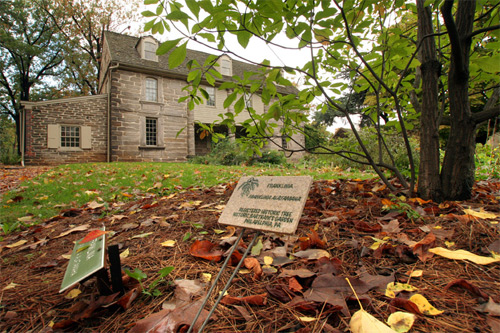
Franklin and the elder Bartram were dear friends; Bartram's idea for a "society or academy of the most ingenious and curious men" evolved, via Franklin, into the American Philosophical
Society. Bartram's esteemed garden was the scene of some of its meetings, and parties were hosted for the likes of Franklin, Jefferson, Washington and even Congress.
To think of Bartram's Garden in modern terms is to wonder how it survived, truthfully. Like the Delaware, most of the lower Schuylkill River (below the Fairmount dam) was developed
industrially or via some other unnatural manner. Andrew Eastwick, for whom the nearby Southwest Philly neighborhood is named, had the foresight and sincerity to purchase the Garden in
1850 for the purpose of preserving it in its entirety. He even built his own home on a hill away from the original home so as to not disturb Bartram's vision. Eastwick's home was
demolished, but a picnic pavilion named for him eventually replaced it.
Bartram's Garden has operated under the auspices of Fairmount Park since 1891, when the City purchased the Garden at the behest of Councilman Thomas Meehan, who was once Eastwick's
gardener. Sunoco operates its massive refinery just downstream, PGW's operation is directly across the river, and DuPont is just on the other side of Grays Ferry Bridge. But here amidst
the industry and post-industry lies 45 acres of trees, flowers, plants, fruits and nature, same as it's been for over 250 years.
Don't be mistaken, though: Bartram's Garden isn't stuck in the 18th century. A wooden boardwalk leads you from the Garden into the woods and along the river, and the trail continues
beyond the planks, past a baseball field and wetlands rebuilt in 1997 (which was flooded by the Schuylkill on Saturday morning), and a boat dock completed last year at the bottom of the
Garden's meadow. That meadow is itself land reclaimed from industry: in the late 1980s, the Garden purchased the shuttered concrete factory next door and began the process of filling it
in -- with land excavated from what would become Liberty Place, and from sewer sludge. Todd Greenberg is right when he says that "everyone in Philadelphia had a hand in creating this
meadow."
It's a proper place to bring this all together and get to the photos. Bartram's Garden's meadow has one of the most majestic and complete views of the Philly Skyline: a wide view, the
Schuylkill River, industrial plants and relics, railroad, and a meadow that was born of that same skyline.
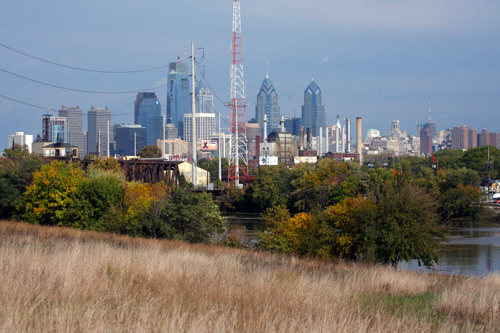
There are 55 photos in this set. The black tupelos, the service berries, the carolina silverbells, the prickly ashes, the honey locusts, the persimmons . . . they all speak for
themselves. Grab yourself a glass of cider and enjoy this photo essay by clicking
For more on Bartram's Garden and John and William Bartram, please see the following:
• Bartram's Garden
• USHistory.org
• American Heritage
• Wiki: John Bartram
• Wiki: William Bartram
–B Love
|
 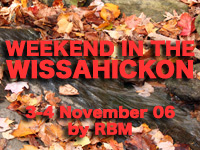 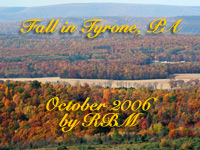 
29 October 07: The Possible City
Wondering about Wandering
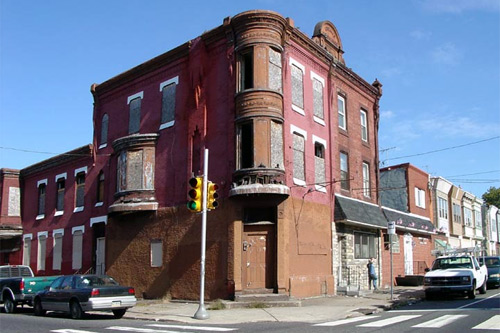
by Nathaniel Popkin
October 29, 2007
Lending itself perfectly to aimless wandering, Buenos Aires is primarily a city of barrios. For many people, these are Buenos Aires' best sights, more intriguing
than most museums, churches or monuments. --Rough Guide to Argentina
Shall we think rigorously about aimless wandering? Inspiring literature, philosophy music, instilling the marvelous expansive feeling of being human, it is, after
all, one the great joys -- and strengths -- of the city. You can hike in the woods and feel profoundly small and yet at ease; you can roam a city and feel utterly
connected.
In a city of neighborhoods, wandering implies leaving your own comfortable realm and heading out to territory unknown, unexplored, un-encountered. It invites the
unplanned, unexpected, unrehearsed, which makes one's world larger and more interesting, one's city richer and ultimately, conversely, after a thousand wanderings,
altogether more comfortable.
I wander because I'm curious, because I need to relax, because I want to be stimulated. Philadelphia's intimate streets often oblige -- and they keep going, which
pulls me along. And each time the city surprises. Each time it becomes more familiar.
So I know it's rotten, boring, fragmented. Wandering only exposes the worn edges.
Far from "lending itself perfectly" our city of neighborhoods is simply derisive to the idea of leaving the parochial block, of stopping somewhere on the way, of
being able to find your way. The result is a place that thinks it is small when, in fact, it is huge; that thinks it is stifling when it might be freeing; that
thinks it is homogenous when it is unendingly pluralistic; that defines neighborhood to mean "my neighborhood," never yours. It isn't a city of neighborhoods,
rather a bunch of neighborhoods each of which thinks it is the entire city.
That's a problem -- not just because it would be nice if it was easier to wander -- but because ultimately a city has to cohere in order to dazzle.
A neighborhoods plan, therefore, can't be a plan for neighborhoods. Rather it must address the ways the parts of the city fit together to make the whole. And it
must invent city-wide responses to shared problems.
I will say this now, lest anyone is confused: our idiosyncratic neighborhoods are a terrific strength, perhaps more intriguing and certainly less polished than
Center City. They are charming places with related but discreet histories, with traditions, with life cycles and daily rituals and institutions. We don't want to
obliterate authenticity (or fetishize it, for that matter). Instead, we just want to treat each as critical to the whole; the treatments may vary.
The first and best thing we can do for the neighborhoods is make Center City larger. Its current small size -- 3 square miles of the total 135 -- limits its
ambition, circumscribes our identity, leads us to think that our city is small. It isn't -- Philadelphia is the 129th largest central city in the world. [source.]
But it is ever-more dependent on what happens in those three square miles. Such a small area simply can't carry one so vast. It's like trying to balance the
elephant on top of the pin.
Center City is already growing of course, first by filling in, then by going up, now pushing out. Parts of what used to be South Philly and North Philly and West
Philly are now really in practice Center City. We're merely going to put a name on those places -- a powerful brand name, in fact. (Keep in mind there is a
difference between the Center City District (CCD) and Center City itself; the CCD already imagines a "greater" Center City but it isn't clear how exactly to
translate the current system of assessment, which pays for services and capital improvements, to a much larger and less commercial area. A future installment of the
Possible City will propose a fiscal device for doing so.) The strategy implicit is to leverage the success of Center City by physically extending its reach. Merely
by growing vertically, even 1,000 feet up, isn't going to do.
I propose to make Norris Street the northern boundary of the new Center City, Morris the southern. Norris to Morris, has a nice ring to it. The east of course is
the Delaware. Do we cross the Schuylkill? Given Cira South and Penn Connects, this is already in motion. 48th Street should be the western boundary -- 48th north
to Girard, including the Zoo. (University City, as Francisville and Brewerytown and Pennsport, would just be part of the center.) Now, at 12 square miles or so,
we've made the center large enough to carry the load.
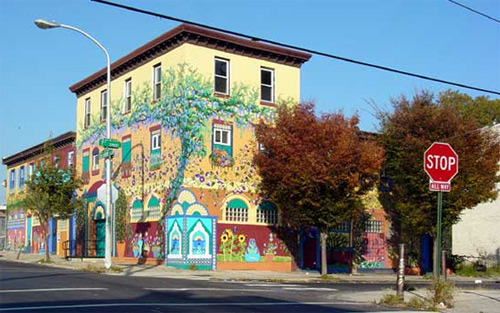
I want to discuss for a moment the importance of physical scale and connections. Our goal is a city robust enough to be a joy to inhabit, where roaming is rewarded.
To make this possible in practice we need to reinforce and redefine connections among places -- it's an act of improving accessibility. The best connector of all is
Center City. Imagine Center City as a compass: it points in all directions; small in size it takes you only so far; much larger its capacity to connect has grown
substantially -- out into the middle band of turn-of-the-century West Philly to Passyunk Avenue to Strawberry Mansion and up into Kensington.
Readers may question how simply re-labeling something could have real, practical effect. We are re-labeling but we're also applying certain criteria for density,
height, parking, transit, lighting, and commercial activity so that the new core becomes just as vital as the current, smaller one. Since most of the expanded area
is already growing in population and generally pretty vital, these new criteria are already beginning to be met. A great deal of thought and nuanced planning will
reveal how to respect current neighborhood patterns while raising the level of performance.
Others might wonder if this is simply a gentrification plan, designed to make property more valuable; still more are saying here we go again: throwing money at
Center City when it's the neighborhoods that need it. Trickle down? Everyone knows that's Voodoo Economics.
Let's bracket those responses for now and assume this bit of surgery has been successful. The center is larger in scale and ambition. It has more resources; it has
appropriate signage and lighting; transit is reorganized to enhance new connections -- and critically, transit signage reinforces the new identity with route and
neighborhood maps displayed at bus, subway, rail, and trolley stops. Better legibility at the core will alone improve performance (imagine arriving by El at Front
and Girard and being able to consult a map).
Urban policy has failed in part because the federal government refuses to fairly distribute income. (In fact, as we know, just the opposite: it loves to exploit and
widen the income gap.) State and local governments without the proper resources are therefore forced to redress inequality. They can't -- and yet urban policy has
been caught up with that un-winnable proposition for forty years. So when we talk about making neighborhoods better it's assumed we mean crafting a response to
poverty. That isn't our task here; rather we're interested in Philadelphia surviving. If it can survive then it is going to make an awful lot of people's lives
better and more rewarding.
There are two structural problems we'd better tackle. Everyone knows the first. Guns are killing places as much as people. Homicide is particularly corrosive
because it pushes certain families out, including the families of victims, and it builds upon itself, it reproduces: one murder makes a handful more. Once the
process begins, watch out! It's like dominoes falling. I don't have the answer to this but to hope that Pennsylvania allows Philadelphia to apply all the resources
it can muster. (John Street's response to this crisis is right, on the face of it. Murders as a function of poverty increase during times of a widening gap between
rich and poor; there isn't much one can do but push the congress to do its job. On the other hand his whimpering response indicates a lack of confidence in our own
ability to respond and an unwillingness to experiment, things I suspect Mr. Nutter will not have to overcome.)
The other structural problem works the same way, only more slowly, and you don't always see it happening. That problem is deferred maintenance. Our row houses are
falling down. The first and most critical to go are the corners (you lose the best architecture and the corner store). Now there are hundreds of blocks that look
like books on a shelf without bookends. We know what happens eventually. Yet -- yet! -- so much of the city is still intact -- there is still a chance to preserve
the traditional fabric, the porches and bay windows, the evocative terracotta and metalwork that give places character and make them worth living in. There is still
time. What we need is a carefully-mapped plan to catch blocks before they fall apart, preferably before the corners are lost. My guess is we have five years to
intervene at scale. I propose a $10 billion fund (100,000 buildings at $100,000 each) to save, preserve, and renovate. In terms of environmental sustainability,
neighborhood improvement, economic development, and fiscal responsibility, there is no more important thing the new Mayor can do.
A fund like that in this city is asking for corruption. Robbery aside, we do need to invent a way to prioritize and leverage the investment we're about to make.
This is called asset-based planning. We need to make the most of the (pretty amazing) assets we already have -- parks and other recreation centers, public
institutions and cultural centers, and transit infrastructure. If we take a map of the city and circle all of those things and then find the overlap, we'll see
where to prioritize the investment of the fund. (Doing so also reverses the current mode, which is to plan strictly from within each neighborhood without seeing the
connections.) Let's take an example--Strawberry Mansion.
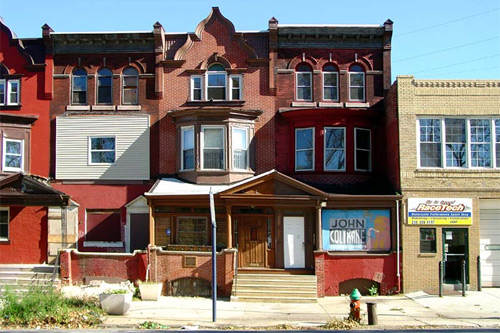
Here's Fairmount Park, the Coltrane House, the R7 (which doesn't have a stop there but should -- I wonder if it did once?), and Strawberry Mansion High School,
altogether a concentration worth leveraging. As a result the park and other institutions become more accessible because their surroundings aren't falling apart; the
city a little bit easier and more rewarding to roam.
Are we ready yet? No?
Indeed not. I want to return to something we just touched on -- access to Fairmount Park. Arguably our greatest resource, it's just not getting used enough. Part
of the joy of roaming the city is getting into the park; aside from Kelly Drive, the park is accessed primarily by car -- and this makes it seem less accessible,
especially to teenage kids who could sure use space to exert some energy. The park, like Center City, is also a connector. Making it more accessible is therefore
critical. The best way to increase park use, of course, is to increase the number of people living around it. Beyond that there are a few bus lines that go to the
park's edge, but fewer that cross it -- and no rail link (the Strawberry Mansion R7 stop might be useful). This is a subject worth its own investigation, perhaps as
Philadelphia attempts to make the most of the renovation of Memorial Hall as the Please Touch Museum.
There's still a bunch of connective tissue missing: that's the commercial avenues. This is also an act of leveraging. Most of these streets and avenues bind
neighborhoods -- or in the current form, act as boundaries. Careful investment can heal two or three or four neighborhoods all at once.
No city is worth roaming unless you can come upon a bookstore you've never heard of, or a taqueria or lunch counter or a place to get Vietnamese Hoagies. What's the
use? But our neighborhood commercial streets are ragged, unpleasant, and boring. Even North Fifth Street, where you can find a menú del día to knock
your socks off (El Bochinche, wow), is oppressively dull and sometimes a little frightening. These places need a combination stewardship, marketing, financing,
streetscape improvements, lighting, evening programming, etc. Proper sidewalk lighting is the absolute key -- capable alone of transformation.
You're wondering when I'm going to start talking about places. Enough of the theory, where specifically? Here, in a list, are some key locations. In a subsequent
post, I'll carefully (re)consider them, imagining newfound roles for these locations. I will also spend some time thinking about the physical act of getting around
Philadelphia. For a grid it sure isn't very legible.
Here's my list:
• Oxford Circle
• Wayne Junction
• North Philadelphia Station
• Kensington and Allegheny
• MCP site
• Lancaster Avenue
• Broad/Snyder/Passyunk
• 52nd Street
• Chester-Woodland-49th to 54th Street
This is a very short list. It doesn't include Delaware waterfront, current Center City or expanded Center City locations -- but it might. I would love it if you
would send me currently/potentially powerful locations anywhere in the city, places that right now have big impact -- or could with some careful investment:
nathaniel.popkin@gmail.com. I'll add those locations to my list so that we can ultimately match ideas with specific locales.
–Nathaniel Popkin
For more on The Possible City, please see HERE.
For Nathaniel Popkin archives, please see HERE, or visit his web site HERE.
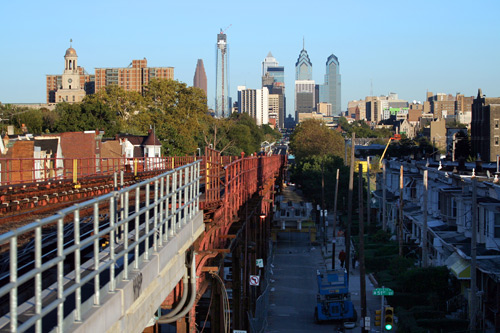
|
   
|





































